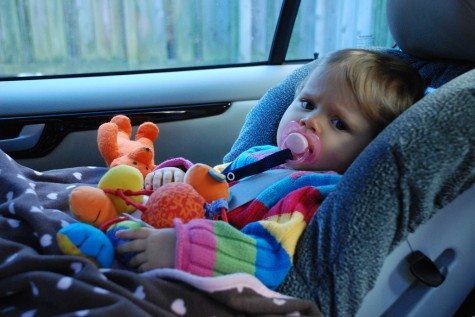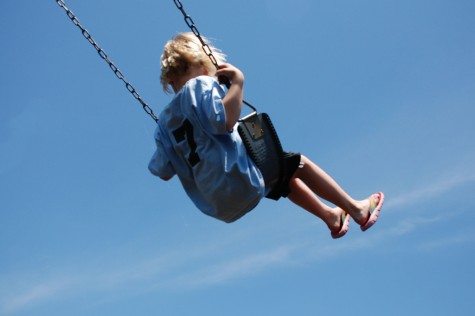
Today’s children sit more than ever. Babies spend hours confined in car seats and carriers rather than crawling, toddling or being carried. As they get older their days are often heavily scheduled between educational activities and organized events. Children have 25 percent less time for free play than they did a generation ago, and that’s before factoring in distractions like TV or video games.
Left to their own devices, children move. They hold hands and whirl in a circle till they fall down laughing. They beg to take part in interesting tasks with adults. They want to face challenges and try again after making mistakes. They snuggle. They climb, dig and run. Stifling these full body needs actually impairs their ability to learn.

We know that our little ones walk and talk on their own timetables. No rewards or punishments are necessary to “teach” them. Yet children are expected to read, write and spell starting at five and six years old as if they develop the same way at the same time. In fact, academics are pushed on preschoolers with the assumption this will make them better students. This approach is not only unnecessary. It may be contributing to problems such as learning disorders, attention deficits, and long term stress.
Literacy isn’t easy. It requires children to decode shapes (the alphabet) into sounds and words, to remember these words correctly in written and spoken form, and to understand their meaning. Allowing reading to develop naturally or teaching it later tends to create eager, lifelong readers. In contrast, teaching children to read early, between four and seven years, is often stressful. Why?

Children pushed to read young tend to rely on right brain processes because that area matures more quickly. These early readers are likely to guess at unknown words using clues such as appearance, context, beginning and ending letters. Their main tactic is memorizing sight words. These are valuable methods but not a balanced approach to reading. Such children may quickly tire after reading short passages or read smoothly but have difficulty deriving meaning from what they read. The procedure they use to decode words can make the content hard to comprehend. These reading problems can persist.
However children benefit when they learn to read naturally or are taught later. That’s because, as the left brain matures and the pathway between both hemispheres develops, it becomes easier for them to sound out words, to visualize meanings, and mentally tinker with abstractions. They memorize short sight words but sound out longer words, an approach that is less taxing. As they incorporate more words into their reading vocabulary they more easily picture and understand what they are reading.

In order for children to read, write and spell they must be developmentally ready. Some are ready at the age of four or five, some not for many more years. This readiness includes complex neurological pathways and kinesthetic awareness. Such readiness isn’t created by workbooks or computer programs. It’s the result of brain maturation as well as rich experiences found in bodily sensation and movement.
These experiences happen as children play and work. This includes expansive movements such as climbing, jumping, digging, swimming, playing hopscotch and catch, riding bikes, sweeping, running. It also includes fine movements such as chopping vegetables, drawing, building, using scissors, and playing in sand. And it includes the essential growth that comes from snuggling, listening to stories, singing, trying new tastes, playing rhyming and clapping games, enjoying make believe. Children are drawn to such experiences. Without them, they won’t have a strong foundation for learning.

These activities stimulate the child’s brain to develop new neural pathways. Such activities also build confidence, smooth sensory processing, and create a bank of direct experience that helps the child visualize abstract concepts. Well-intended adults may think a good use of a rainy afternoon is a long car ride to an educational exhibit. A young child is likely to derive more developmental value (and fun) from stomping in puddles and digging in mud followed by play time in the tub.
There are many other factors contributing to reading readiness. Perhaps most important is a supportive family life where reading and conversation are an enjoyable part of each day. But it helps to remember that young children want to participate in the purposeful work of making meals, fixing what’s broken, and planting the garden. They also need free time without the built-in entertainment of specialized toys, television, or video games. Their development is cued to movement. These bodily experiences prepare children for the magic found when shapes become words, words become stories, and they become readers.



Nice post.
As a homeschooler I had the luxury of letting my kids read at their own pace. For my daughter, she learned to read by writing. She could care less what books said (though she loved to have books read to her) but she wanted to write down all the thoughts and stories and letters in her head right away! She didn’t start reading books until around six or seven. This is normal, but for a precocious child, people thought I should push her. I didn’t. She’s fine. And a fantastic writer.
My son started reading at nine. If he had been in school, he would have been in the “special” classes, labeled, and would have grown up thinking reading was a horrible chore. At twelve he reads above level and loves it.
Even without pressure from me, the family around us was worried about him. My husband required him to read the first sentence from their nightly book before my husband would read the rest of the chapter.
My son understood the concept of reading, but didn’t care until he was in the middle of a manga called Whistle. He was getting frustrated at missing half of the plot by only looking at the pictures. I dryly suggested he might read some of the dialogue. He did. “OH! That’s what’s going on!”
After finishing that manga series, he read a 400 page novel that had a cool cover.
Your experiences are so consistent with those of homeschoolers/unschoolers who have the luxury of time to let children learn to read on a more natural timetable. In the school environment it’s an emergency if a child doesn’t read because nearly every other subject is taught and evaluated via reading. Those of us who homeschool/unschool can continue to let learning be a more direct, hands-on experience.
Peter Gray recently did a study of children who learned to read on individual timetables. Some read early and some not until they were pre-teens. All of them became enthusiastic readers. And really, isn’t that the goal?
I also find this frustrating with writing. After a supposed age- children are expected to write on every assignment in traditional school or in curriculum packs. The sheer processing issues and stress of that much writing sent my oldest daughter into tears.
As adults- we get tired after writing about 1-2 pages of text and we have fully developed skills! Can you imagine the strain writing puts on children’s bodies and minds when EVERY subject has a writing element?
Great article!
I go into this at length in my book, but the process of separating “learning” into pre-planned segments that are typically taught, regurgitated in assignments, then evaluated/tested is actually the antithesis of learning. It tends to lead to shallow thinking and low motivation. It astonishes me that we don’t recognize and respond to how children really learn.
As a mom of a 4 year old (and a 2 year and 5 month old) the pressure to put my child in preschool is IMMENSE. The best place for my child is with his family. We attend enough classes (mommy and me, art, gymnastics, etc) and have plenty of outings but preschool is not necessary academically or even socially. We are planning to homeschool as a large number of family and friends are already doing. Thank you for such an encouraging article!
I could not agree more! The best thing homeschooling did for me was to remove the artificial barriers between “playing,” “living,” “working,” and “learning.” Both of my kids are back in school for various reasons, but this understanding helps me put it all in perspective. Thank you for writing it!
As a teacher, I have tried to explain this to parents so many times. From now on, I’m just directing them to you.
Kelly, if you like, make this article a hand-out. I’d appreciate it if you’d include my name and book title.
Thank you! We have Open House next week. I’d love to include this and will be sure to include your name and book title.
You would not believe how many Kindergarten parents are pushing their children to read early. It’s like it’s become a contest to see who can do it first.
Thanks for the work you do Kelly. My father, aunt, and grandmother all taught elementary school. It’s a labor of the heart.
Where to send my 5 yo to school has really been weighing on me. I know I am not up to home schooling, public options are very one size fits all, and the Waldorf and montesouri programs cost so much.
I totally agree that letting him learn at his pace makes sense, and Im even torn between sending him to Kindergarden (again) or first grade. This article seems to make me lean towards the former. I don’t want him to feel like he’s “
Teachers usually don’t recommend letting students repeat kindergarten unless there are significant problems. If he already went through that program you may want to talk to the teacher as well as support staff to get an idea of what’s best for your son.